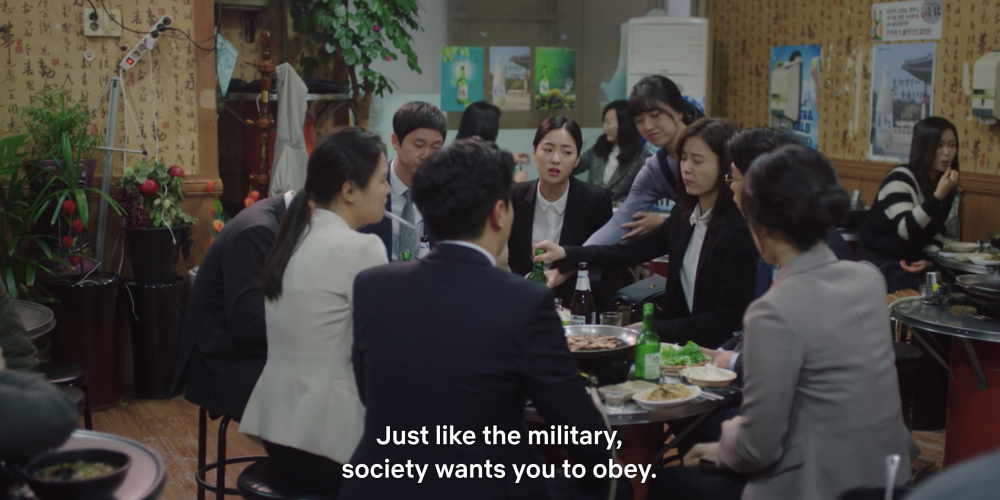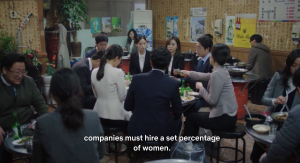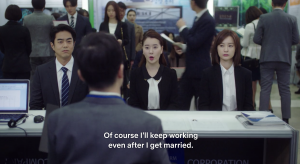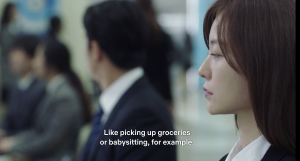Synopsis:
Because of Ho Cheol’s death and betrayal of his beloved Ju Yeong, O Yang Chon demoted from Senior inspector to inspector and was sent to Hong-il constabulary. Unfortunately, Jang Mi asks Yang Chon for a divorce and other police officers in Hong-il constabulary do not see him as the “legendary.” On the other hand, Sang Su and Haeri are jealous of Jung-O who gets all the attention from the other police officers. However, when Jung-O went to the homicide scene, she gets devastated and cannot forget the horrible scene. In addition, Yang Chon criticizes Sang Susaying that he doesnot show any commitment to his position from the first day of work.
Discussion:
Like Dr.Saeji has mentioned in our first lecture, Korea can be described into five concepts: collectivism, hierarchy, shame, nationalism and competition. Throughout the drama, we can easily illustrate all five concepts in different way. Not only the main characters but also the sub characters indicate different perspective of lives. When I deeply look into the drama differently than the usual, I see several problems that Korea is now facing. At first, nothing seems eccentric in the drama. However, once you think and look into the issues that we, Koreans, are having, everything will start to lookodd thinking about a question such as “why would they do such a thing?”
From the beginning of the drama, it clearly shows that Korea is one of the competitive countries where it focuses on higher education, showing that people live their lives to the fullest by studying for several years to get accomplishments that they are desired of. According to Kim and Choi, people who received 4-year college education receive 150% more than the high school graduates and also there are 160% wage differences comparing what university or college he or she has graduated from and they will be treated differently in Korean society (Kim and Choi 2015, 457-458). For example, in episode 4, the drunk members of parliament commit violence toward Han Sol without any hesitation since they know that they are in higher positions than the ordinary police officers. I believed that this scene is actually showing the tragic side of Korean society in order to criticize the effects of social stratification and how the status in reality is certainly important (Ibid., 457).
Another fact that I would like to point out is the circumstance that we talked about in our lecture that elderly poverty rate is constantly rising in Korean society. The growth rate overall population aging, from 7.2% in 2000 to 12.7% in 2014 but Korea is not well prepared for the upcoming aged society, especially in terms of serious low-income issues (Jeon 2017, 175). As we see in the episodes, we can truly tell the differences between Yang Chon’s economic status and his father’s economic status just by looking at their houses. Yang Chon lives in an apartment in an urban area whereas his father lives in a rural area by himself; the society is becoming more and more difficult for the middle-aged people to live, raising their children plus taking care of their aging parents as well. Elderly parents do not want their middle-aged children’s help, knowing that they are having a hard time as well. Therefore, the single elderly in poverty is ranked as the highest in the OECD (lecture).
In conclusion, the problems in Korean society can be easily found. Overall, however, I believe that the drama itself magnifies the problems more seriously than the actual problems.
Largely, we can think about the questions such as:
- Do you think we can see the social stratification in our daily lives? Or is it exaggerated in the dramas?
- As a UBC student, do you think that receiving higher education really effects not only in Korea but also in Canadian society?
Bibliographies:
- Doohwan Kim, and Yool Choi. “The Irony of the Unchecked Growth of Higher Education in South Korea: Crystallization of Class Cleavages and Intensifying Status Competition.” Development and Society44, no. 3 (2015): 435-63. Accessed September 27, 2018. doi:10.21588/dns.2015.44.3.004.
- Jeon, Boyoung, Haruko Noguchi, Soonman Kwon, Tomoko Ito, and Nanako Tamiya. “Disability, Poverty, and Role of the Basic Livelihood Security System on Health Services Utilization among the Elderly in South Korea.” Social Science & Medicine178 (February 14, 2017): 175-83. Accessed September 27, 2018. doi:10.1016/j.socscimed.2017.02.013.



